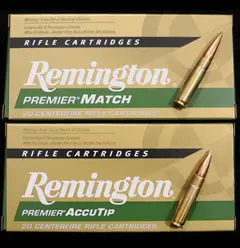|
The .300 Blackout (.300 Blk. or 7.62x35mm) By Chuck Hawks  This is another quasi-military cartridge attempt to get AR-15 platform rifles off their knees in terms of hitting power. The .300 Blk was developed by Advanced Armament Corp. SAAMI standardized ammunition has been introduced by Remington. The factory loaded bullet weights are 115 grains (Rem./UMC) and 125 grains (Rem. Premier). These supersonic .300 Blk loads are intended for use from a 16" AR-15 barrel. AAC and Remington have also developed a 220 grain subsonic load for use in silencer equipped M4 carbines with 9" barrels. This weapon is illegal for civilian use without a special permit, since the minimum barrel lengths allowed by the BATF are 16" for rifles and 18" for shotguns. Ballistically, the .300 Blk is the near ballistic twin of the 7.62x39 AK-47 cartridge (faint praise, indeed!). In a practical sense, what one can do the other can do. It shoots the same weight bullets at about the same velocity. This makes it a poor choice for all big game and most other hunting applications, as its lightweight (115-125 grain), low velocity, .308" bullets lack both energy (for hitting power) and sectional density (for penetration). AAC promotes the .300 Blk as a .30-30 level hunting cartridge, but this is not true. As a hunting cartridge it is substantially inferior to the .30-30 in every way: bullet weight, sectional density (SD), velocity, energy and trajectory. With a varmint/plinking weight 115 grain bullet the Remington/UMC .300 Blk factory load claims a muzzle velocity (MV) of only 2295 fps and muzzle energy (ME) of 1344 ft. lbs. The slightly heavier 125 grain bullet (SD .188), the alleged "big game" load, achieves only 2215 MV and 1360 ft. lbs. ME. At 200 yards the figures for the latter load have diminished to 1767 fps and 867 ft. lbs. For comparison, the very popular Hornady LeverEvolution load for the .30-30 Winchester launches a 160 grain bullet at a MV of 2400 fps and ME of 2046 ft. lbs. The 200 yard .30-30 figures are 1916 fps/1304 ft. lbs. Perhaps more important, the Hornady FTX bullet has a SD of .241! Also grossly misleading is AAC's claim that the effective range of the .300 Blk is 460 meters (498 yards). This claim is based on "M4 military standards for hit probability." Specifics are not supplied on the AAC website, but Guns and Shooting Online correspondent Lance Robson informed me that, "It is based on a 50% first round hit probability when fired by a trained marksman at an exposed single standard E type silhouette that is 23.5" wide and 39.25" tall. Testing is conducted on a standard Army known distance range where all shooting is done from prone unsupported or prone supported (sandbags) positions." Unfortunately, 50% hit probability anywhere on a man size target is not relevant to the sportsman. What we need to know is the cartridge's maximum point blank range (MPBR) +/- 3". The actual MPBR fired from a rifle with a standard sight height of 1.5" shooting a Remington 125 grain AccuTip bullet (BC .335) at a MV of 2215 fps, is 216 yards. In other words, at 216 yards the bullet drops 3" below the line of sight. The bullet's maximum midrange rise (+3" above the line of sight) occurs at 105 yards. Zero distance for MPBR is 184 yards. Incidentally, at 460 meters/500 yards that bullet drops 94.6", or about 7.9 feet! At this point, you might be wondering, "What is the point of this cartridge?" Certainly, I was. Here, straight from AAC, is their justification for developing the .300 Blackout: DESIGN OBJECTIVES
� Utilize existing inventory magazines while retaining their full capacity � Create the optimal platform for sound and flash suppressed fire � Create compatible supersonic ammo that matches 7.62x39 ballistics � Provide the ability to penetrate barriers with high-mass projectiles � Provide all capabilities in a lightweight, durable, low recoiling package One might reasonably ask why we need a .30 caliber "solution" for the AR platform, given the proven superiority of existing 6.5mm and 6.8mm cartridges, why civilians need an optimal platform for (illegal) sound and flash suppressed fire, or what is the point of merely matching the capabilities of the 7.62x39 cartridge--which is already widely available and at best an inferior sporting cartridge. (It is a proven military assault rifle cartridge, widely favored by terrorists, to be sure.) The design objective to "provide the ability to penetrate barriers with high-mass projectiles" is an obvious red herring, since the high velocity (supersonic) .300 Blk. loads shoot light-for-caliber bullets. If you want to shoot heavy (180+ grain) .30 caliber bullets at supersonic speeds, get a .308 or .30-06. As to durability, the AR-15 platform does not compare favorably to most sporting rifles. Truth in advertising is apparently not a consideration at Advanced Armament Corp. The .300 Blk seems to be a suitable plinking or home defense round. It is about as good as, but no better than, the 7.62x39 and clearly inferior to the 6.8mm SPC. That may not sound like much of a recommendation, but my job is to report the facts to you, gentle reader, not promote new products for arms and ammunition manufacturers. |